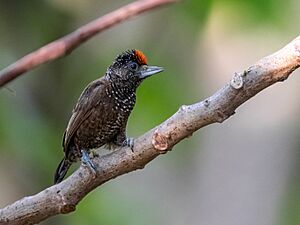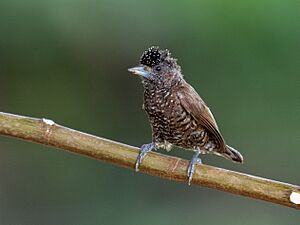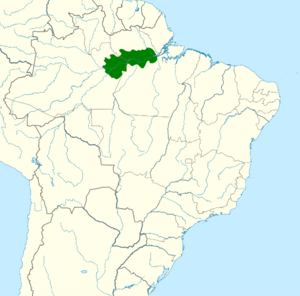Varzea piculet facts for kids
Quick facts for kids Varzea piculet |
|
|---|---|
 |
|
| male | |
 |
|
| female | |
| Conservation status | |
| Scientific classification | |
| Genus: |
Picumnus
|
| Species: |
varzeae
|
 |
|
The varzea piculet (Picumnus varzeae) is a small bird found only in Brazil's Amazon basin. It is part of the woodpecker family. This bird is considered a Near Threatened species, which means it could become endangered if its habitat isn't protected.
Contents
About the Varzea Piculet's Name
The varzea piculet was first described in 1912. This means it was officially named and studied for the first time that year. The person who described it was Emilie Snethlage, a German-Brazilian ornithologist. An ornithologist is a scientist who studies birds.
Some experts think the varzea piculet might be a type of spotted piculet (P. pygmaeus). Sometimes, it even mates with the white-barred piculet (P. cirratus). When two different but related species mate and have offspring, it's called hybridizing.
The second part of its scientific name, varzeae, comes from the word "várzea". This is a Brazilian name for forests that get flooded every year. These forests are usually found near the Amazon River. The varzea piculet is a monotypic species, meaning it doesn't have any different subspecies or types.
What Does the Varzea Piculet Look Like?
The varzea piculet is a small bird, about 8 to 9 centimeters (3 to 3.5 inches) long.
- Males: Adult male varzea piculets have a black cap on their head. They have a red patch on their forehead and the top of their head. White spots can be seen on the back of their head and neck. Their face is mostly dark brown.
- Females: Adult females look almost the same as males. The only difference is that they do not have any red on their head.
- Both: Their upper body is mostly dark olive-brown to greenish-brown. Their wings are dark brown with lighter edges. Their tail is dark brown, with some white on the inner feathers. Their throat is black-brown with small white marks. Their belly and chest are usually brown or greenish-brown. Their eyes are brown, their beak is black with a blue-gray base, and their legs and feet are gray.
- Young Birds: Young varzea piculets look like the adults. However, they have more stripes or bars on their underparts.
Where Does the Varzea Piculet Live?
The varzea piculet lives only along the Amazon River in Brazil. Its home stretches from the Rio Negro in the state of Amazonas to the Rio Tapajós in western Pará. This area is about 850 kilometers (530 miles) long and up to 275 kilometers (170 miles) wide.
This bird prefers to live in the thick plants found in várzea. This is a special type of landscape that gets flooded during certain times of the year. It includes forests, grasslands, and islands in the river.
Varzea Piculet Behavior
Movement
The varzea piculet stays in its home area all year round. It does not migrate to other places.
Feeding Habits
Scientists do not know much about what the varzea piculet eats. They also don't know how it finds its food. More research is needed to understand its diet and foraging techniques.
Reproduction and Life Cycle
The breeding season for the varzea piculet is not fully known. It might be from June to December. Young birds have been seen in September. Other details about how they reproduce are still a mystery to scientists.
Vocalization (Sounds)
The varzea piculet makes sounds, but there are not many recordings of its song. As of early 2023, only a few recordings exist. Scientists have not yet written down or described what its song sounds like.
Varzea Piculet Conservation Status
The IUCN (International Union for Conservation of Nature) is an organization that assesses the risk of extinction for species. They first said the varzea piculet was of "Least Concern." Then, in 2012, they changed it to "Endangered." In 2022, they changed it again to "Near Threatened."
The varzea piculet lives in a small area. Its total population size is unknown, but it is believed to be shrinking. The biggest threat to this bird is that its forest home is being cleared. People are cutting down the trees to create land for cattle to graze.
Another possible threat in the future comes from two hydroelectric dams. These dams are being built upstream from where the bird lives. They might change how the river floods, which could harm the bird's habitat. Brazilian authorities currently consider this bird to be Endangered. More information is urgently needed about this species' life and how it reproduces.


